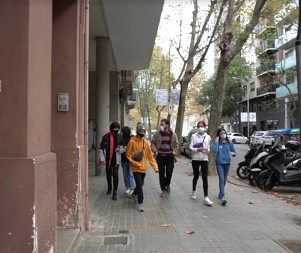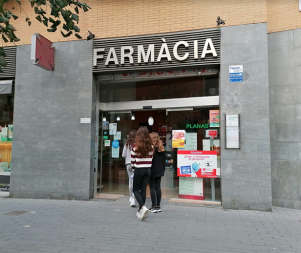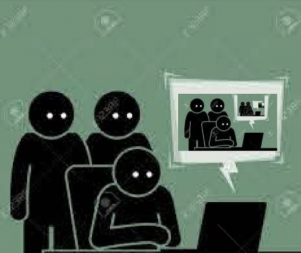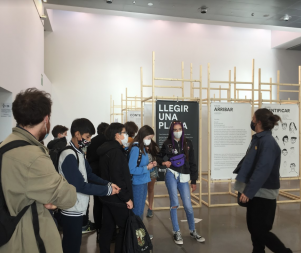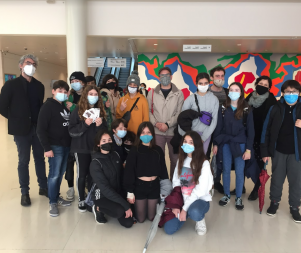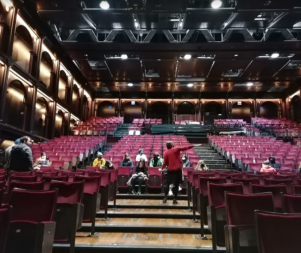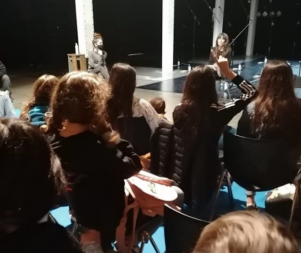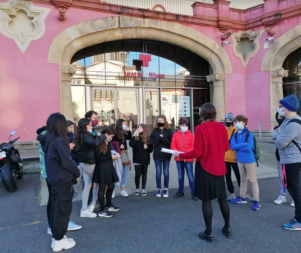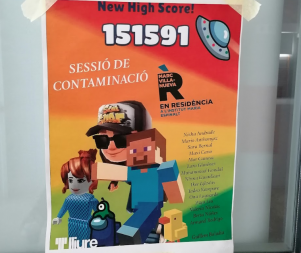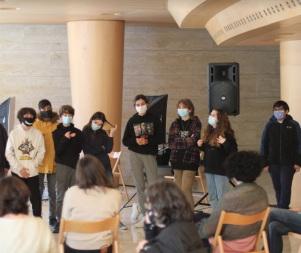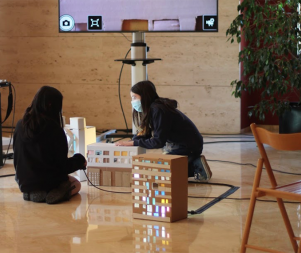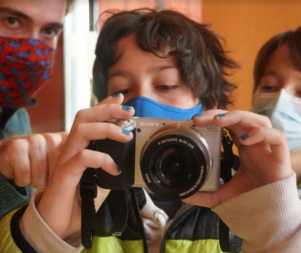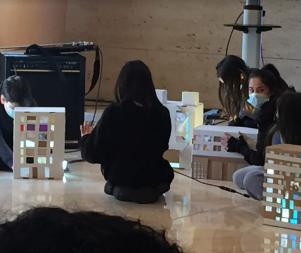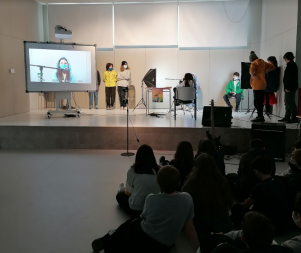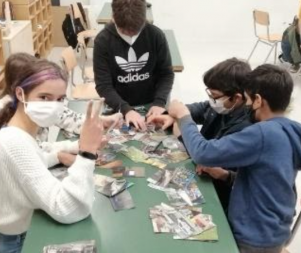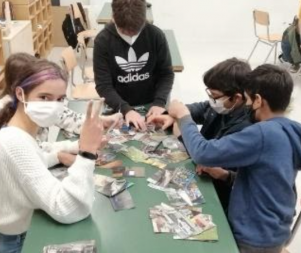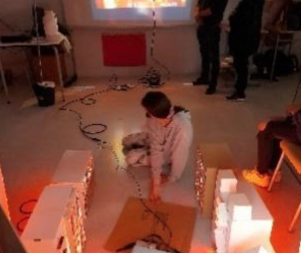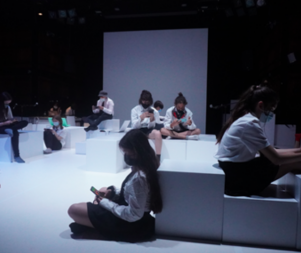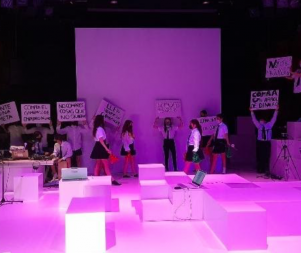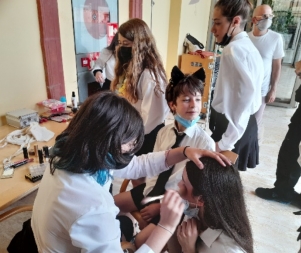- 14th EDITION 2022 / 2023
- 13th EDITION 2021 / 2022
- 12th EDITION 2020 / 2021
- 11th EDITION 2019 / 2020
- 10th EDITION 2018 / 2019
- 9th EDITION 2017 / 2018
- 8th EDITION 2016 / 2017
- 7th EDITION 2015 / 2016
- 6th EDITION 2014 / 2015
- 5th EDITION 2013 / 2014
- 4th EDITION 2012 / 2013
- 3rd EDITION 2011 / 2012
- 2nd EDITION 2010 / 2011
- 1st EDITION 2009 / 2010
Marc Villanueva IN RESiDENCE at the School Maria Espinalt
This text is written in the feminine gender, because Marc Villanueva wanted to introduce this form of expressing oneself during the whole process, and thus better reflect the reality of the residence.
1. SHORT DEFINITION OF THE MEANING OF THE CREATION PROCESS CARRIED OUT AND THE MOST SIGNIFICANT TOPICS AND SITUATIONS:
The lights come on when we leave school was the creative process and research into stage language that the creator Marc Villanueva Mir wanted to develop with the Year 8 students of Institut Maria Espinalt during the 2020/21 season. Marc’s work processes are characterised by an open space for research and a collective work around a constellation of concepts, and they end up taking shape through a practice of experimentation with non-conventional formats and their possibilities for becoming games or devices that are open to participation. The initial idea was to suggest this methodology, in which the form emerges from the content, in order to design a project that places special emphasis on the circumstances and questions of the group of students taking part.
2. DESCRIPTION OF THE WORK OR RESULTING WORKS
The show consisted of a series of scenes that explored the topic from the different angles worked on throughout the process, interviews in which they explained their day-to-day in video games, hair-raising advice on how to become a millionaire within a game, an audiovisual journey through the Poble Nou neighbourhood, a choreography inspired by Fortnite...All with an interdisciplinary, diverse and contemporary execution of the performing arts that includes a debate at the end, with the direct participation of the audience with questions relating to the project. The opening performance took place on 26 May 2021.
3. TOPICS
The project commenced under the sign of COVID-19 and loaded with all the questions that the lockdown had generated. Some of these questions formed the starting point for exploring the tensions between the body and authority, using the language of the stage and performing arts. But Marc also wanted to begin the process with a clear topic in mind: work and money. What does work mean? Why do we work? Do money and work always go together? Why? Should we charge for working at home? Should we charge for looking after family members or animals? For going to school?
4. PORTRAIT OF THE “CREATION PROCESS”. THE KEY MILESTONES OF THE CREATION PROCESS
1. STREET INTERVIEWS – FIELDWORK
One of the most important phases in Marc Villanueva’s creative processes is the research and investigation phase. One of the methodologies used was to take to the streets and interview and record different people working. They looked for people working in shops, security guards, builders, couriers, cleaning staff, trainers and gyms, Metro workers, hairdressers, chemists, mechanics… At the beginning they only recorded them working, but afterwards they expanded the research to include short interviews.
2. THE DIGESTIONS
Marc proposed that the entries in the blog should form part of the creation process and the students should be active subjects. After each session, during the first half of the residence, a student would make an individual reflection on what was transferred into the blog in an audiovisual format. These entries were known as digestions. They enabled the students to express themselves more freely and for abilities and voices that had been camouflaged within the group to come out.
3. FIELD TRIPS
There were lots of field trips during the process. Institut Maria Espinalt showed a great deal of interest and made it possible. Some field trips were closely linked to the process itself and others were more to do with the IN RESIDENCE programme in general. They were all very positive in enriching the process. They went to the Read a square exhibition by the illustrator Clara Nubiola IN RESIDENCE with the Institut Salvador Espriu at the DHUB. They also visited the facilities at Teatre Lliure. And later on the Art and myth exhibitions. The gods of Prado and So lazy at Caixaforum. There was also an open rehearsal for Artifices and Leopards at Fabra i Coats as part of the Quinzena Metropolitana de la Dansa. And finally they went to two functions which formed part of the Teatre Lliure programme: Strangers will come…, by Marta Galan, and Frank, by Clara Manyós and Xesca Salvà.
4. THE MASH-UP SESSIONS
There were two mash-up sessions One at the school, attended by all the Year 8 students and teachers, and another at Teatre Lliure for the workers at the theatre. A work in progress of the piece was shown at both including everything that had been worked on up until that moment that would serve to put it to the test. The execution of the proposal (lights, sound, audiovisuals…) were done in situ by the students. The spontaneous and dynamic debate opened up by the students themselves at the end of the two mash-up sessions about the general topic, work and money, was of particular note.
5. ARTISTS OF REFERENCE
Throughout the whole process, Marc shared numerous artistic references with the students connected with the work that was being done and were very useful for obtaining ideas and creating a shared common imaginary: Antje Ehmann and Harun Farocki, Sybille Peters, Forced Entertainment, David Espinosa, Über Leben
6. INVITED ARTISTS
We had the assistance of four artists who visited us during different sessions during the process to tell us of their experience and to go into detail with regard to some specific aspects of the proposal. Carlos Gallardo, a manipulator of objects, gave us a session on how to animate objects to explain history. Xesca Salvà, scenographer, gave a workshop on building mock-ups. Gerard Valverde, a composer, introduced us to the world of electroacoustics, and Pau Matas, audiovisual designer, showed us the language of the cinematographic camera.
7. PUBLIC PRESENTATION: THE LIGHTS COME ON WHEN WE LEAVE SCHOOL
On 26 May, the process The lights come on when we leave school was presented to an audience of 30 people. Three performances were given and a preview with an audience at the school. It is of note that each scene came from an impulse or intuition that had come up during the classroom or in the rehearsal room. The show consisted of a series of scenes that explored the topic from the different angles worked on throughout the process, interviews in which they explained their day-to-day in video games, hair-raising advice on how to become a millionaire within a game, an audiovisual journey through the Poble Nou neighbourhood, a choreography inspired by Fortnite... All with the interdisciplinary, diverse and contemporary execution of the performing arts.

